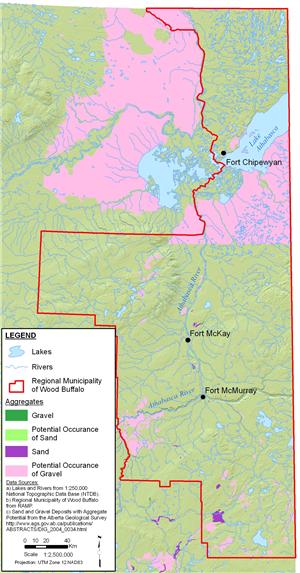Aggregate Mining - an overview
The term “aggregate” refers to coarse particulate material such as crushed stone, gravel, sand, clay, and marl. Aggregate is used in the construction of buildings, roads, dams, and other infrastructure as a base material or in composite material such as concrete. In Alberta, the most common uses of aggregate include road construction, concrete production, and various other purposes such as filtration in septic fields, backfill in underground mines, winter road sanding, and as “rip-rap” that armours shorelines and watercourses against erosion (Richards and Peel 2004).
Gravel and sand are usually extracted from the same site because they are often found together in characteristic landforms, including (Edwards 1998a):
- Alluvial deposits, which result from the deposition of gravel and sand from running water. These deposits are found in floodplain and valley terraces.
- Glaciofluvial deposits, materials that were initially moved by glaciers and later sorted during deposition by flowing glacial meltwater.
- Preglacial fluvial deposits, which were deposited prior to the most recent glacial event.
In Alberta, most aggregate resources have glacial origins, with only 10% of the provincial aggregate resources resulting from recent alluvial deposition. However, current production is disproportionately reliant on alluvial deposits, as these aggregate sources are generally located on or near the earth’s surface, and are easier to find and cheaper to extract.
Given northern Alberta's glacial geography, aggregate mining in the region focuses on glacial and fluvial deposits of gravel and sand. Some 99% of the aggregate extracted is sand and gravel, mostly from the Alberta Plains, east of the foothills and front ranges of western Alberta (Edwards 1998a). The aggregate resources of the Fort McMurray region are largely glaciofluvial, with major meltwater-channel deposits adjacent to the Clearwater and Athabasca rivers (Scafe 1988). Sand and gravel deposits are also found on the MacKay River and Stony Mountain (Fox 1980).
Bedrock is usually extracted from below the surface at sites that are selected based on the qualities needed in the end product. In northern Alberta, bedrock extraction is used to acquire limestone, which is processed into quicklime and used to remove impurities such as sulphur dioxide from smokestack emissions.









